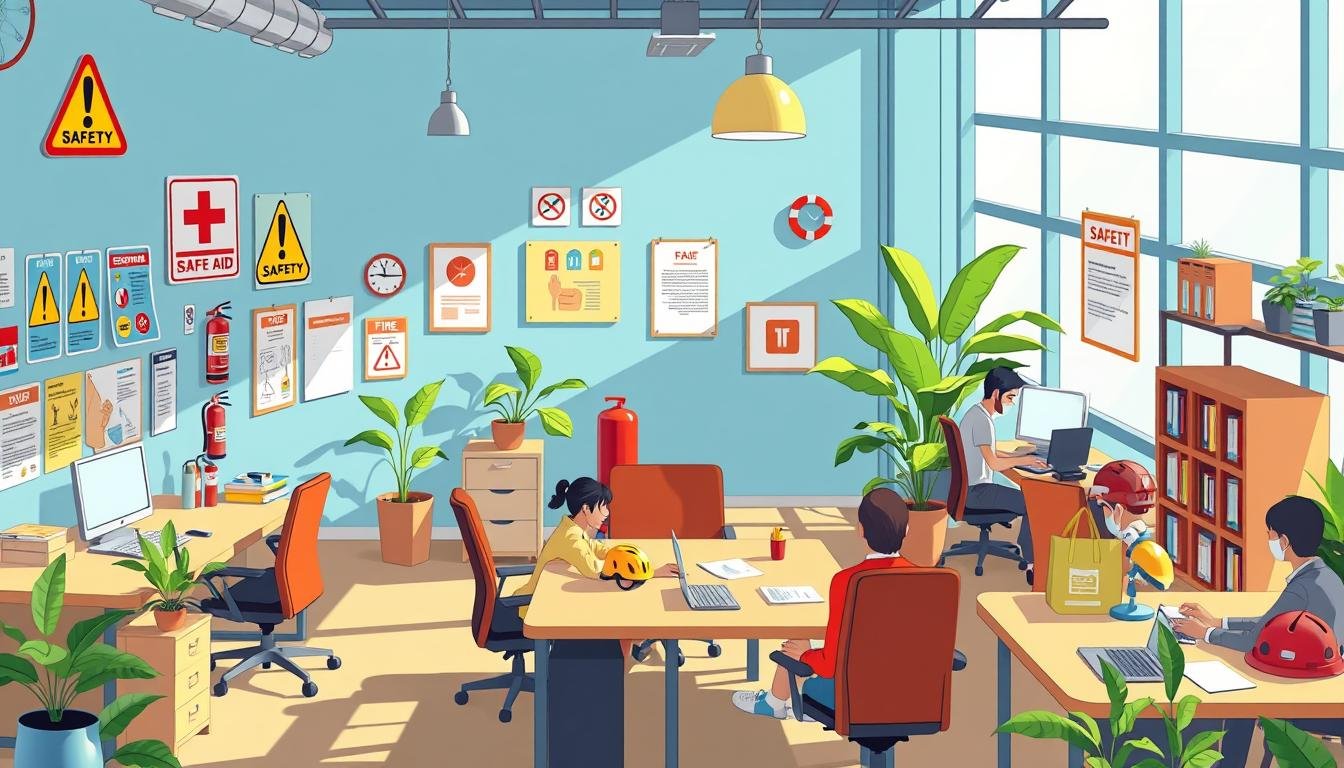Creating Workplace Safety Initiatives: The Psychological Keys to Success
Ever wondered why some workplaces do well while others struggle? It might be because of something called psychological safety. This idea is changing how we think about keeping employees safe and happy at work.
In today’s fast world, psychological safety is key. It’s not just about keeping people physically safe. It’s about making a place where employees can share ideas, take risks, and make mistakes without fear.
The World Health Organization shows us why this is so important. Every year, 12 billion workdays are lost to depression and anxiety. This costs the global economy a trillion dollars. We need to focus on making workplaces safe for both body and mind.
Let’s dive into how making workplaces psychologically safe can change things. It can make your team more innovative, engaged, and productive. Are you ready to help your team reach their full potential?
Key Takeaways
- Psychological safety is crucial for employee engagement and innovation
- 12 billion workdays are lost annually due to mental health issues
- Effective workplace safety initiatives address both physical and psychological aspects
- Open communication and risk-taking are hallmarks of psychologically safe environments
- Implementing psychological safety can lead to increased productivity and employee retention
Understanding Psychological Safety in the Workplace
Psychological safety is key to a great work place. It boosts employee performance and sparks new ideas. Let’s explore what it is and why it’s important.
What is Psychological Safety?
Psychological safety means employees can be themselves and share ideas without fear. In such places, everyone’s voice is heard, mistakes are okay, and taking risks is encouraged.
Four Key Dimensions
Psychological safety has four main parts:
- Willingness to help others
- Embracing inclusion and diversity
- Positive attitude towards risk and failure
- Encouraging open conversations
Impact on Workplace Dynamics
The effects of psychological safety are huge. It makes employees more creative and innovative. A McKinsey survey showed 89% of employees think it’s vital.
It also makes workers more committed. When leaders invest in their growth, 64% more employees see them as inclusive.
| Benefit | Impact |
|---|---|
| Innovation | Increased creativity and risk-taking |
| Retention | Higher employee commitment |
| Communication | Improved knowledge sharing |
| Learning | Greater openness to feedback |
By promoting psychological safety, companies can tap into their team’s full potential. This leads to happier employees and better business results.
The Importance of Workplace Safety Initiatives
Workplace safety initiatives are key to keeping employees safe and boosting company success. In 2019, Ohio saw over 91,000 workplace injuries. This shows how important it is to have strong safety plans.
Good safety plans can really help. Companies with strong safety efforts see fewer workers’ comp claims. This means big savings and better profits. Health and safety programs can cut illness and injury rates by 20-40%.
A safe workplace also makes employees happier and more productive. Happy workers are up to 20% more productive. This helps the company do well.
- 75% of workers are more likely to stay with companies prioritizing safety
- Workplace safety programs can lower injury incidences by 9% to 60%
- Companies spend $170 billion annually on workplace incident-related costs
Putting safety first builds trust and respect in the workplace. It leads to more innovation and better communication. In short, safety is not just a rule; it’s the key to a successful company.
Assessing Your Organization’s Current Psychological Safety Climate
Knowing your organization’s psychological safety climate is crucial for a positive work place. This means doing a deep dive into psychological safety and listening to what employees have to say. It helps understand the current state of your organization’s climate.
Using the Psychological Safety Scale
The psychological safety scale, made by Amy Edmondson, is a great tool for checking how your workplace works. Employees share their thoughts on their work environment. This gives clues on four key areas: teamwork, diversity, risk-taking, and open talks.
Identifying Areas for Improvement
Looking at your assessment results shows what’s working and what’s not. A Deloitte study shows leaders in top-performing teams are 28 times more likely to learn from mistakes. This shows how vital it is to have a place where employees can safely try new things and learn from mistakes.
Establishing Baseline Metrics
To see how you’re doing, you need to set baseline metrics. Regular surveys can give you feedback right away and help avoid focusing on the latest news. Remember, you always need to check in and adjust to keep your workplace safe and open.
By building trust in your team and leaders, you can make a place where everyone feels free to speak up. This leads to better reporting of mistakes and a safer work environment.
| Dimension | Impact on Psychological Safety |
|---|---|
| Willingness to Help | Fosters teamwork and collaboration |
| Inclusion and Diversity | Enhances innovation and problem-solving |
| Attitude to Risk and Failure | Encourages learning and growth |
| Open Conversation | Promotes transparency and trust |
Developing a Culture of Open Communication
Creating a culture of open communication is key for better employee engagement and a stronger workplace culture. Only 7% of workers say they have accurate, timely, and open communication at work. This shows many places need to do better.
Open communication brings big benefits. Companies with engaged employees see a 17% boost in productivity and a 51% drop in staff turnover. They also see a 23% rise in profits. This shows how important it is to have a place where everyone feels free to share their thoughts.
To build this culture, organizations should:
- Encourage two-way talks between management and employees
- Use regular pulse surveys to get feedback
- Work on building trust between executives and employees
- Make a safe space for sharing opinions and concerns
By focusing on open communication, companies can see a 25% boost in productivity. This comes from better information flow, more trust, and teamwork. When employees have the info they need, they’re 2.8 times more likely to be engaged.
Open communication is more than just talking; it’s about listening, understanding, and acting on feedback. By building this culture, companies can make their workplaces safer and more innovative. This leads to greater success overall.
Implementing Effective Risk Assessment Strategies
Risk assessment is vital for workplace safety. It helps find and fix potential dangers before they cause harm. Let’s look at how to make risk assessment work well in your company.
Identifying Potential Workplace Hazards
Finding dangers is the first step. Look closely at your work area, how things are done, and what tools are used. Hazards include physical risks like falls, bad work setups, and stress.
Involving Employees in the Risk Assessment Process
Getting employees involved is crucial. They know the dangers in their jobs. Make sure they can talk about risks without fear. This helps find more hazards and makes everyone more involved in safety.
Creating Mitigation Plans
After finding hazards, make plans to fix them. These plans should cover physical and mental risks. Use the best methods to lower or remove dangers. Keep these plans up to date as your workplace changes.
“Companies that prioritize safety report higher employee satisfaction, reduced absenteeism, and lower turnover rates.”
Workplace safety is an ongoing job. Do regular safety checks, train employees, and use safety software. This way, you’re not just following rules. You’re making your company and its people better for the long run.
Designing Comprehensive Safety Training Programs
Effective safety training is key to a safe workplace. It covers physical and mental health, ensuring all aspects are addressed. Training should begin when someone is hired and continue as procedures and equipment change.
WorkSafeMT stresses the need for clear safety guidelines. This reduces confusion and ensures everyone knows their role. Training should teach about hazards, safety measures, and job-specific protocols. This approach fosters a safety-conscious culture.
- Cover both physical and psychological safety aspects
- Include modules on recognizing and addressing mental health risks
- Incorporate training on open communication and conflict resolution
- Provide regular refresher courses to keep pace with evolving workplace dynamics
- Ensure training for new employees and those transitioning to new roles
Keeping records is vital for workplace safety. Keep records for workers’ compensation and government checks. A written safety policy is the base, outlining roles, responsibilities, and consequences for not following rules.
| Training Component | Description | Frequency |
|---|---|---|
| New Employee Orientation | Introduction to workplace safety protocols | Upon hiring |
| Hazard Recognition | Identifying potential workplace risks | Annually |
| Emergency Procedures | Response to workplace emergencies | Bi-annually |
| Mental Health Awareness | Recognizing signs of stress and burnout | Quarterly |
By using these strategies, companies can build a strong safety training program. This program promotes a safe and healthy work environment.
Establishing Clear Incident Reporting Procedures
Incident reporting is key to keeping workplaces safe. A good system makes sure everyone feels they can report incidents. This leads to a safer work environment.
Creating a Non-Punitive Reporting System
A non-punitive system is vital for good incident reporting. It lets employees share incidents without fear. This encourages honesty and helps find and fix problems early.
Encouraging Employee Participation in Reporting
Getting employees to report incidents is important. Training them on the value of reporting helps a lot. Keeping them informed about the process keeps them involved.
Using Incident Data for Continuous Improvement
Looking at incident data helps improve safety. Regular reviews help spot trends and fix ongoing problems. This makes safety efforts more effective.
| Report Type | Description | Importance |
|---|---|---|
| Near Miss Report | Events that could have caused harm | Prevents future incidents |
| Injury Report | Accidents resulting in employee harm | Tracks severity and frequency |
| Exposure Incident Report | Contact with hazardous substances | Ensures proper follow-up care |
Remember, reports must go to the right people within 15 days. Good systems have clear records with all the details. Keeping everyone updated helps build trust and makes the workplace safer.
Incorporating Ergonomic Initiatives for Employee Well-being
Ergonomic initiatives are key to improving employee health and comfort at work. They help reduce physical strain and increase productivity. Let’s look at some important ergonomic strategies and how they affect employee health.
The U.S. Bureau of Labor Statistics says strains, sprains, and tears were the top work injuries in 2020. This shows how crucial ergonomic measures are. A study in Applied Ergonomics found that ergonomic tools can greatly lower injury risks and make employees happier.
Good ergonomic setups can prevent many health issues. For example, ergonomic chairs support the back, hips, and thighs. This helps keep a good posture and avoids lower back pain. Standing desks let you switch between sitting and standing, which is better for your posture and blood flow.
- Ergonomic workstations reduce eye strain and headaches
- Footrests help maintain ideal seating posture
- Standing desks promote better circulation
Starting ergonomic initiatives is more than just making work comfortable. It shows your company cares about your health, creating a better work place. This can make employees happier, work better, and be more productive.
| Ergonomic Initiative | Benefit |
|---|---|
| Adjustable chairs | Prevent lower back pain |
| Standing desks | Improve posture and circulation |
| Ergonomic keyboards | Reduce risk of carpal tunnel syndrome |
| Proper lighting | Decrease eye strain and headaches |
By focusing on ergonomic efforts and comfort, companies can make their workforce healthier and more productive. It’s important to regularly check and ask for feedback from employees. This helps keep these efforts effective in improving their well-being.
Workplace Safety Initiatives: Building a Psychologically Safe Environment
Creating a safe environment at work is crucial. It builds trust and encourages new ideas. Let’s look at how to start this important work.
Fostering Trust and Respect Among Team Members
Trust is the foundation of a safe workplace. A study found that 72% of employees share unique ideas in safe spaces. To build trust, talk openly and value different opinions. Let team members speak up without fear.
Encouraging Innovation and Risk-taking
Innovation grows in safe places. Teams that take risks solve problems 30% better. Celebrate learning from mistakes and hold “lessons learned” sessions. This way, teams see challenges as chances to grow.
Promoting a Growth Mindset
A growth mindset is key for safety. Training on this boosts employee happiness by 35%. Encourage seeing challenges as chances to learn. This mindset improves team performance and innovation.
| Psychological Safety Factor | Impact on Workplace |
|---|---|
| Open Communication | 72% increase in unique perspectives shared |
| Risk-taking Encouragement | 30% improvement in problem-solving skills |
| Psychological Safety Training | 35% increase in employee satisfaction |
| Leadership Vulnerability | 60% increase in idea expression |
By focusing on these areas, companies can make a safe work environment. This boosts trust, encourages new ideas, and improves safety efforts.
Ensuring Regulatory Compliance While Maintaining Psychological Safety
It’s important to balance regulatory compliance with psychological safety in the workplace. Companies need to keep up with changing safety standards and laws. At the same time, they should create a space where employees feel safe sharing their concerns.
Regular compliance audits are key. Companies should review new processes every quarter and established ones every six months. Keeping policies updated with the latest industry standards and laws is also crucial.
Working with a Professional Employer Organization (PEO) can be very helpful. A PEO can guide companies through complex legal rules. They help understand and keep up with changes in workplace safety laws.
“Compliance training should be a regular event to reinforce procedures and ensure staff familiarity with expectations.”
To keep both regulatory compliance and psychological safety in check, companies should:
- Make policies and procedures easy to find in both paper and digital formats
- Apply policies fairly to everyone in the organization
- Clearly explain policy changes and why they’re needed
- Offer specific training to help employees understand and support new policies
By focusing on these steps, companies can build a safe and compliant work environment. This leads to happier employees and better business outcomes.
| Compliance Aspect | Recommendation | Impact on Psychological Safety |
|---|---|---|
| Audit Frequency | Quarterly for new processes, bi-annual for established ones | Ensures up-to-date practices without overwhelming employees |
| Policy Updates | Based on industry best practices and changing laws | Demonstrates commitment to employee safety and well-being |
| Training | Regular compliance training events | Builds confidence in handling workplace safety issues |
| Policy Access | Available in paper and electronic formats | Promotes transparency and trust in the organization |
Conclusion
Workplace safety is key for success. Companies that focus on both physical and psychological safety help employees do their best. The East Longmeadow factory, run by Cartamundi for Hasbro, is a great example. It brought Play-Doh production back to the U.S. thanks to strong safety measures.
Companies like Alcoa show the benefits of safety. They aimed for zero injuries and saw their revenues triple. This shows how safety can boost a company’s finances.
It’s important to have good safety management systems. OSHA suggests tracking both leading and lagging indicators to see how well safety is working. Companies that care about safety have fewer injuries, lower costs, and keep employees longer. In fact, 75% of workers prefer to stay with a company that values their health.
Creating a safe and trusting work environment is essential. It leads to innovation and growth. This approach not only keeps employees safe but also helps companies succeed in today’s fast-paced world.
Source Links
- 11 Ways to Create Psychological Safety at Work | Achievers
- 8 ways to create psychological safety in the workplace
- Psychological Safety and DEI – Toward a Respectful Workplace
- What is psychological safety?
- 5 Reasons Why Your Workplace Safety Program Matters
- The Importance of Workplace Health and Safety
- Workplace Safety Examples: A Guide To Best Practices
- How to Build a Psychologically Safe Workplace
- Measuring psychological safety and local learning to enable high reliability organisational change
- The importance of open communication in the workplace | Blink
- 3 Ways Communication Enhances Workplace Safety
- Risk Assessment and Management for Safety Professionals
- Implementing Effective Workplace Safety Protocols: A Guide for Safety Managers – Gables Search Group
- The Importance of a Risk Assessment in Workplace Safety
- 5 Steps to Developing an Effective Workplace Safety Program
- 15 Safety Training Topics for Your Workplace (and Free Courses!) | EdgePoint Learning
- Implementing a Workplace Safety Program
- Incident Reporting in the Workplace: A Guide for Employers – Ethena
- 5 Steps to Create an Effective Incident Reporting Procedure
- Workplace Ergonomics Safety: Tips, Equipment, and Examples
- A Conceptual Framework for Integrating Workplace Health Promotion and Occupational Ergonomics Programs
- Enhancing employee engagement and safety through targeted well-being programs
- Creating a Psychologically Safe Environment
- What is psychological safety at work? Here’s how to start creating it
- How To Ensure Compliance In The Workplace: 9 Tips – GenesisHR Solutions
- Empowering ethics: Unleashing compliance program success through psychological safety | JD Supra
- Conclusions and Recommendations – Health and Safety Needs of Older Workers
- How Workplace Safety Improves Performance
- Workplace Safety Tips: Ultimate Guide To Ensuring Safety







